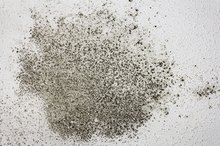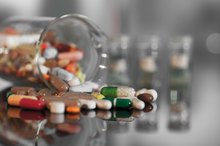What does fact checked mean?
At Healthfully, we strive to deliver objective content that is accurate and up-to-date. Our team periodically reviews articles in order to ensure content quality. The sources cited below consist of evidence from peer-reviewed journals, prominent medical organizations, academic associations, and government data.
- Yeast Colonies of Candida albicans on Agar Medium for Growing Candida
- Budding Yeast, Common Saccharomyces of Bread, Wines and Beer
- Budding Yeast, Common Saccharomyces of Bread, Wines and Beer
The information contained on this site is for informational purposes only, and should not be used as a substitute for the advice of a professional health care provider. Please check with the appropriate physician regarding health questions and concerns. Although we strive to deliver accurate and up-to-date information, no guarantee to that effect is made.
What Is the Difference Between a Yeast Infection & Fungus?
A yeast is a special type of "budding" fungus. Candida albicans is a common yeast organism that causes yeast infections in humans 1. The term "fungus" applies to yeasts as one group of the fungus kingdom (Mycota). Molds are the other organisms which belong to the fungus kingdom.
If you are experiencing serious medical symptoms, seek emergency treatment immediately.
How to Tell a Yeast from a Mold Fungus
Yeasts have been known ever since the days of making and baking bread. Yeast, when added to flour, causes the flour to rise, hence the term "leavened" bread. This leavened bread could more accurately be called "yeast" bread.
Yeasts bud. When they reproduce, they blow out a small part of their wall, like a balloon, and expand that bud into another yeast, which eventually separates and falls away. Molds are fungi. Fungi produce filaments or threads called "hyphae." In summary, yeasts bud, but molds form filaments, or hyphae.
- Yeasts have been known ever since the days of making and baking bread.
- Yeast, when added to flour, causes the flour to rise, hence the term "leavened" bread.
How Does a Yeast Infection Really Differ from a Mold Infection?
Getting Red Yeast Rice Out of Your System
Learn More
Typically, Candida albicans is the biggest culprit in yeast infections. Candida causes infections of mucocutaneous membranes of the mouth, gastrointestinal tract, and the genitalia. The yeasts reproduce rapidly by budding, and are enriched in their growth by carbohydrates (sugars and starches) in the body tissues. Fungi of the mold group often cause different types, signs and symptoms of infectious disease.
- Typically, Candida albicans is the biggest culprit in yeast infections.
- The yeasts reproduce rapidly by budding, and are enriched in their growth by carbohydrates (sugars and starches) in the body tissues.
Yeast Infection and Mold Infection Defined Further
Infection in the classic definition means that a microorganism, such as a yeast or mold, has entered into or onto the body. A person can become infected with a microbe and not become diseased. When the microbe—yeast, mold, bacterium, virus—begins to multiply in the infected site, then there is actual disease. So, a true yeast infection, in most cases, is best termed "yeast disease," but by common acceptance when someone has a yeast infection it is understood that they have a diseased state that must be treated.
- Infection in the classic definition means that a microorganism, such as a yeast or mold, has entered into or onto the body.
- So, a true yeast infection, in most cases, is best termed "yeast disease," but by common acceptance when someone has a yeast infection it is understood that they have a diseased state that must be treated.
Treating Infections of Yeast and Molds
Symptoms of Candida Fungi in the Lungs
Learn More
There are antibiotics that can be used to treat yeast and mold infections. These fungal antibiotics are different from those used for bacterial infections.
Summary, A Yeast Infection is a Fungus Infection, but it is Not a Mold Infection
Finally, when someone says they have a yeast infection—that is clear. When someone says they have a fungus infection, you can ask, "Is it a yeast, or a mold?" That question is clarified here.
Related Articles
References
- Yeast Colonies of Candida albicans on Agar Medium for Growing Candida
- Budding Yeast, Common Saccharomyces of Bread, Wines and Beer
- Planned Parenthood. What is a yeast infection?
- InformedHealth.org [Internet]. Cologne, Germany: Institute for Quality and Efficiency in Health Care (IQWiG); 2006-. Vaginal yeast infection (thrush): Overview. 2019 Jun 19.Available from: https://www.ncbi.nlm.nih.gov/books/NBK543220/
- Singh A, Verma R, Murari A, Agrawal A. Oral candidiasis: An overview. J Oral Maxillofac Pathol. 2014;18(Suppl 1):S81–S85. doi:10.4103/0973-029X.141325
- Jeanmonod R, Jeanmonod D. Vaginal Candidiasis (Vulvovaginal Candidiasis) [Updated 2020 Feb 4]. In: StatPearls [Internet]. Treasure Island (FL): StatPearls Publishing; 2020 Jan-. Available from: https://www.ncbi.nlm.nih.gov/books/NBK459317/
- InformedHealth.org [Internet]. Cologne, Germany: Institute for Quality and Efficiency in Health Care (IQWiG); 2006-. Oral thrush: Overview. 2012 Apr 26 [Updated 2019 Aug 15].Available from: https://www.ncbi.nlm.nih.gov/books/NBK367586/
- Blostein F, Levin-sparenberg E, Wagner J, Foxman B. Recurrent vulvovaginal candidiasis. Ann Epidemiol. 2017;27(9):575-582.e3. doi:10.1016/j.annepidem.2017.08.010
- Aguin TJ, Sobel JD. Vulvovaginal candidiasis in pregnancy. Curr Infect Dis Rep. 2015;17(6):462. doi:10.1007/s11908-015-0462-0
- Rajalakshmi R, Kalaivani S. Prevalence of asymptomatic infections in sexually transmitted diseases attendees diagnosed with bacterial vaginosis, vaginal candidiasis, and trichomoniasis. Indian J Sex Transm Dis AIDS. 2016;37(2):139–142. doi:10.4103/0253-7184.192121
- Ringdahl EN. Treatment of recurrent vulvovaginal candidiasis. Am Fam Physician. 2000;61(11):3306-12, 3317.
- Aguin TJ, Sobel JD. Vulvovaginal candidiasis in pregnancy. Curr Infect Dis Rep. 2015 Jun;17(6):462. doi: 10.1007/s11908-015-0462-0.
- Blostein F, Levin-Sparenberg E, Wagner J, Foxman B. Recurrent vulvovaginal candidiasis. Ann Epidemiol. 2017 Sep;27(9):575-582.e3. doi: 10.1016/j.annepidem.2017.08.010.
- Chew SY, Than LT. Vulvovaginal candidosis: contemporary challenges and the future of prophylactic and therapeutic approaches. Mycoses. 2016 May;59(5):262-73. doi: 10.1111/myc.12455.
- Roberts CL, Algert CS, Rickard KL, Morris JM. Treatment of vaginal candidiasis for the prevention of preterm birth: a systematic review and meta-analysis. Syst Rev. 2015 Mar 21;4:31. doi: 10.1186/s13643-015-0018-2.
- Xie HY, Feng D, Wei DM, Mei L, Chen H, Wang X, Fang F. Probiotics for vulvovaginal candidiasis in non-pregnant women. Cochrane Database Syst Rev. 2017 Nov 23;11:CD010496. doi: 10.1002/14651858.CD010496.pub2.









